Probably the most contentious gardening topic I deal with online is the native vs. nonnative plant debate. This, unfortunately, is a debate that is more based in emotion than science, and I don’t intend to stir that pot again. We’ve discussed it on this blog before (you can find a list of them here), and I’ve published both a literature review and a fact sheet on the science relevant to tree and shrub selection. What I want to do in this post is compare two research papers, both in peer-reviewed journals, that come up with dramatically different conclusions.
The first has been getting a lot of publicity on the web and in social media. It was published just two days ago, but because of widespread PR prior to release it appears over 37,000 times in a Google search. The title – “Nonnative plants reduce population growth of an insectivorous bird” – and much of the prerelease publicity about the article spells doom and gloom. It’s a message that gets traction.
The second was published a year earlier and is entitled “Native birds exploit leaf-mining moth larvae using a new North American host, non-native Lonicera maackii.” It appears 194 times in a Google search, even though it’s been available for over a year.
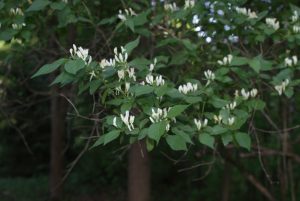
The reason I’m singling out these two articles is they have completely different messages – and one of them is not being heard as loudly as the other. The first focuses on a single bird species, the Carolina chickadee (Poecile carolinensis) and its diet in urban landscapes. Their conclusion: “…properties landscaped with nonnative plants function as populations sinks for insectivorous birds.” Thus, any gardener who happens to use introduced ornamental plants in their landscape is made to feel guilty for starving their insect-eating birds. (As an aside with my manuscript reviewer hat on – this statement has no business being in an abstract as it overextrapolates the research on one species to include ALL insectivorous birds.)
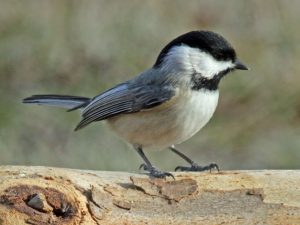
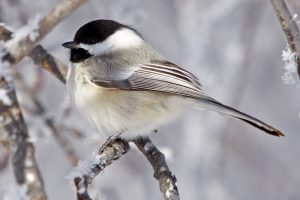
The second article has a different focus. It reports the feeding of black-capped chickadees (Poecile atricapillus) on the larvae of a leaf-mining moth (Phyllonorycter emberizaepenella). While leaf miners are common food items for chickadees, the point of this article was to document the host of the leaf-miner – a nonnative and particularly invasive species of honeysuckle (Lonicera maackii).
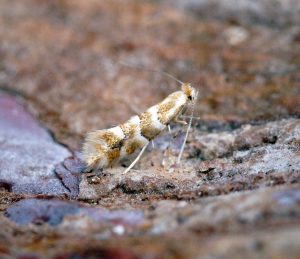

Chickadees as a group are particularly adept at finding and consuming leaf miners, whose tunnels normally protect them from insectivorous birds. Chickadees move along branches,“examining leaves both above and below them; the chickadees sometimes scanned by hanging upside-down.” This makes it easier to find and extract leaf-miners, as the underside of the leaf is easier to tear open than the surface. And in fact this behavior is reflected among other species of chickadee and leaf-miner: “Similarly, in 15 years of study, Connor et al. (1999) never observed species other than Carolina chickadees (Poecile carolinensis) feeding on the larvae of the gracillarid Cameraria hamadryadella [oak leaf miner].” While these are not the same species of leaf miner studied in this paper, the point is that chickadees eat leaf-mining insects. And leaf-miners can obviously adapt to new food sources, including introduced plants. This is basic ecological science.
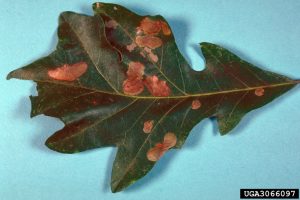

Neither Craves’s article (the second of these two articles) nor that by Connor et al. (cited within Craves’s article) are cited by Narango et al. (2018 – the first article), even though both are certainly pertinent to the topic. But they don’t fit the narrative – which is that introduced plants are not good food sources for the insects that chickadees eat. So they are left out of the discussion, which by default is now biased – not objective. Not science-based.
And I don’t have a good answer to the obvious question – which is why we continue to demonize noninvasive, introduced plants in the absence of a robust body of evidence supporting that view.
Good post. Forgive me if you have covered this already, but the University of Kentucky has done extensive research, which is ongoing, on pollinator plant preferences. You can read more at this link: https://uknow.uky.edu/research/uk-entomology-research-reveals-list-bee-friendly-plants
Essentially, the research is revealing that preferences are all over the map, native AND non-native. Some are very attractive, some are not, and it has little to do with whether the plant is native. One of the highest scoring trees is Seven Son Flower. I have heard so many times that native pollinators only like native plants. Research is showing otherwise. As per your post, you could certainly pick out one non-native in this research and say it is not all that attractive to pollinators, but you could also pick out one native and do the same!
I completely agree with the theme of your post and we have the same blinkered thinking and pro native propaganda over here in the UK
Your post encapsulates a difficulty I have with gardening needing to be science and research based – the problem is which science?
As I tell people during my seminars on scientific literacy – any paper that contradicts the existing body of science must clear a high bar and is therefore subject to close scrutiny. Science does evolve. But strong, incontrovertible evidence is required to overturn working hypotheses. In this case, the science strongly supports the use of trees and shrubs that provide habitat to wildlife regardless of provenance.
Often the most difficult task in science is in figuring out what is the most important question to ask. It seems to me an important question for gardeners is how to design a garden that promotes insect diversity and wildlife habitat. What are the principles? You cannot answer this by doing countless studies of individual species or cultivars. You need to consider habitat structure, layering, microclimates and relationships with surrounding habitats. This is more of an ecosystem question than an individual plant question. We know that native ecosystems with diverse structures and species tend to promote high insect diversity. We don’t know very well how to create this with small gardens or restored habitats. It’s important to know as you point out that there is a lot more to the story than just looking at native vs non native. If you want to promote diversity in a garden then it’s important to first think about the garden not as an odd collection of plants but as an ecosystem that is part of a larger landscape. Whether or not a given plant is going to help promote insect diversity will depend not only on the chemistry & nutrition of its leaves and structure but also what grows around it. Always a good thing to encourage people to think about this! The fact that a chickadee can utilize insects in an invasive honeysuckle doesn’t necessarily tell us whether it is better to plant this species vs. a native honeysuckle or a diverse native ecosystem if your goal is to promote wildlife diversity.
Actually, your comment that “We know that native ecosystems with diverse structures and species tend to promote high insect diversity” is not accurate. My literature review on the topic (mentioned in the blog) demonstrates that landscape structure and plant function is more important than nativity. Please read that article, which is hotlinked in the post.
The comment “We know that native ecosystems with diverse structures and species tend to promote high insect diversity” is accurate. It does not imply that ecosystems must be native to promote diversity. It merely states that such native ecosystems tend to promote high insect diversity, and they do.
Let’s not be silly. Ecosystems with introduced plants with diverse structures also promote high insect diversity. The subjective label “native” is unnecessary and suggests that nonnative systems wont’ do the same thing.
Why not just say landscapes with diverse structures promote high insect diversity?
Linda, please take a deep breathe and actually read what wrote. We agree. All I wrote was that it is true that native landscapes generally promote high insect diversity, and they do. There is plenty of research supporting that. There is also an increasing body of research which strongly suggests such diversity can be achieved in non-native or hybrid landscapes with diverse structures I referenced that in a previous reply. This is being demonstrated at many locations, including the Cincinnati Zoo and Botanical Gardens. CZBG is actively conducting counts to document insect diversity in such plantings and is publishing those results on an ongoing basis. The two statements are not contradictory and can be simultaneously true. So, I agree that “landscapes with diverse structures promote high insect diversity.” That could be a native landscape, a non-native landscape, or a hybrid landscape. Can’t we all just get along?
The more the structure, the more diverse the insects that will come, should also be couched with an asterisk on plant function, as plant function varies by species. For example, some pollinator-dependent plants have high sugar content in their nectar, but low mineral nutrients, and vice versa. They co-evolved along with the local pollinators. Safe to say non-native plants are no different when it comes to function. If your garden-planted non-native gets munched by insects, or its berries get eaten clean by birds, then it’s serving some function other than just structure i.e. cover, though many gardeners intuitively don’t want to select plants that get heavily munched and instead select plants that look/stay relatively pristine all growing season. It’s the “invasiveness” by growing regions that gardeners should be concerned about. Non-natives that are invasive in a particular climate, while providing structure, can essentially be a biological desert when it comes to function due to their lack of “palatability”. Pair Lonicera maackii’s allelopathic leaf character trait with it’s seed productivity and you have a shrub that is spreading rapidly across both urban and rural eastern United States. Your comment “The subjective label “native” is unnecessary and suggests that nonnative systems wont’ do the same thing” [as native systems] for insect diversity is also subjective as it will also depend on the details of the component plants to determine if the individual insect diversity is interacting with an ecologically functional environment or merely attracted to the structure itself. Not black and white for sure tho! Thanks for the food for thought!
Finding non-native plants in the forest near by home is disheartening. They shade-out and take-over a variety of habitats to the detriment of local ecosystems. Surely whether a non-native can support insects and this birds is not the only consideration.
You’re talking about invasive species, which I am not including in my comments about nonnatives. Only a small fraction of introduced plants become invasive and degrade natural areas. Noninvasive, nonnative species are not a detriment to landscapes. You need to read the fact sheet that I linked to in the post. It discusses this issue in detail.
Thank you for your reply. I will check the link.
Sorry – should read: ‘thus birds’ not this birds.
. To be clear, we must differentiate between non-native and invasive, however, we must use caution when defining plants in such a way to alleviate any concern regarding the use of non-native plants which may potentially become invasive. It can often take years before we realize that a non-native specimen has become an invasive, and usually it is too late to remediate those damages. Keep in mind, per your comment that a “small fraction of introduced plants become invasive”, that those which do culminate as invasive negate that premise as they prove to become catastrophically disastrous to native plant and animal communities. Please research the large-scale impacts of those “fractional” species. We must also address all effects of non-natives rather than homing in on songbirds and insect relationships. Consider the number of plants themselves that have become rare and endangered or those that have been extirpated regionally as a result of a few non-native plants that have become invasive. We should turn a blind eye to losing native plants because chickadees are thriving around Lonicera? I suppose it is in the end more of a philosophical discussion, as it appears that there are for whatever reasons, those within the scientific community that support both viewpoints. Perhaps each of us must decide whether we wish to promote native diversity or rather be fully prepared to accept what is to come through novel ecosystems whatever the cost.
All good points. I wonder if we will ever eradicate the invasives already introduced. There are more questions than answers. What about native species already facing extinction? What about genetic modification which could conceivably allow us to re-introduce species facing extinction American chestnut)? What about genetic modification which could conceivably render invasives sterile? What about biodiversity in a world economy enhanced by a more diverse palette of plants, moved around purposefully or accidentally by world commerce (which I doubt will go away)? Will we ever be able to return to pure native ecosystems (the local park district has had an aggressive Amur honeysuckle eradication program and when they let up for a few years the Amur honeysuckle comes right back)? These are just some questions to be asked in this debate, not statements backed by research. These are perhaps questions for researchers to investigate. I am sure they are looking into some of this already. The natives vs. non-natives debate is not just contentious, but very complicated. Like the global warming debate, simplistic conclusions and simplistic solutions are just that, simplistic. A research based course needs to be charted but I’m not sure anybody knows what that should be.
I have seen numerous native landscape restoration projects which were installed but not aggressively maintained. Such restoration projects rapidly become horrendous weed patches full of invasive species and weedy natives and are simply not sustainable without aggressive intervention. Many jurisdictions which implement such strategies look at them as a way to cut down on maintenance costs and have no idea and sometimes no interest in maintenance. Do we really have the will or the resources to go all native on any scale? If it sounds like I oppose native landscapes, that is not the case. I am simply asking questions based on observation and personal experience. Until and unless research proves we can do this cost effectively and with the resources available to most jurisdictions, I will remain VERY skeptical.
I’ve been reading a lot of linked posts about this discussion this morning and I’ve come to a few conclusions about my own behavior as an urban gardener:
1. I want ALL THE PLANTS and I try to cram as many plants in as possible. So long as I go tall (trees and shrubs) where I have space, I will achieve structural diversity.
2. I love both native and non-native plants. I love roses. If I indulge my love of non-natives, I should make sure to balance that with my love of natives. I shouldn’t have all roses; I should balance with other plants.
3. It is much easier to buy non-native than it is natives. It is easy to accidentally buy invasive species (still sold near me!). To buy natives I often have to buy seeds online or plants at a biannual native plant sale. As much as possible, I should patronize these to balance the ease of non-native purchases.
4. Lots of plants (native and non-native) are too “thuggish” for small urban gardens. Suckering is no good in a small space! Exuberant self-sowing is a no-no!
5. Given that it is so much harder to buy natives, one must grab the chance when one can. Why is it so hard to buy native perennials, this makes me so sad.
I was interested in the literature review and the fact sheet listed in the original post, but both of the links are not working – does anyone have working links? Thanks!
Hi – I fixed the broken link for the fact sheet, but the literataure review link seems to work fine. Try copying and pasting it into your browser to see if that helps.
Oh wonderful – thank you!